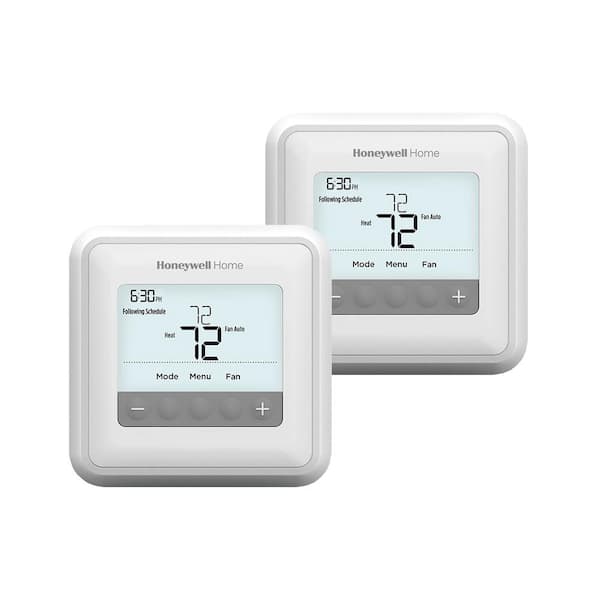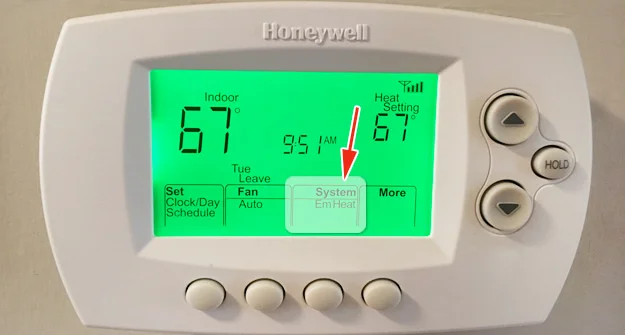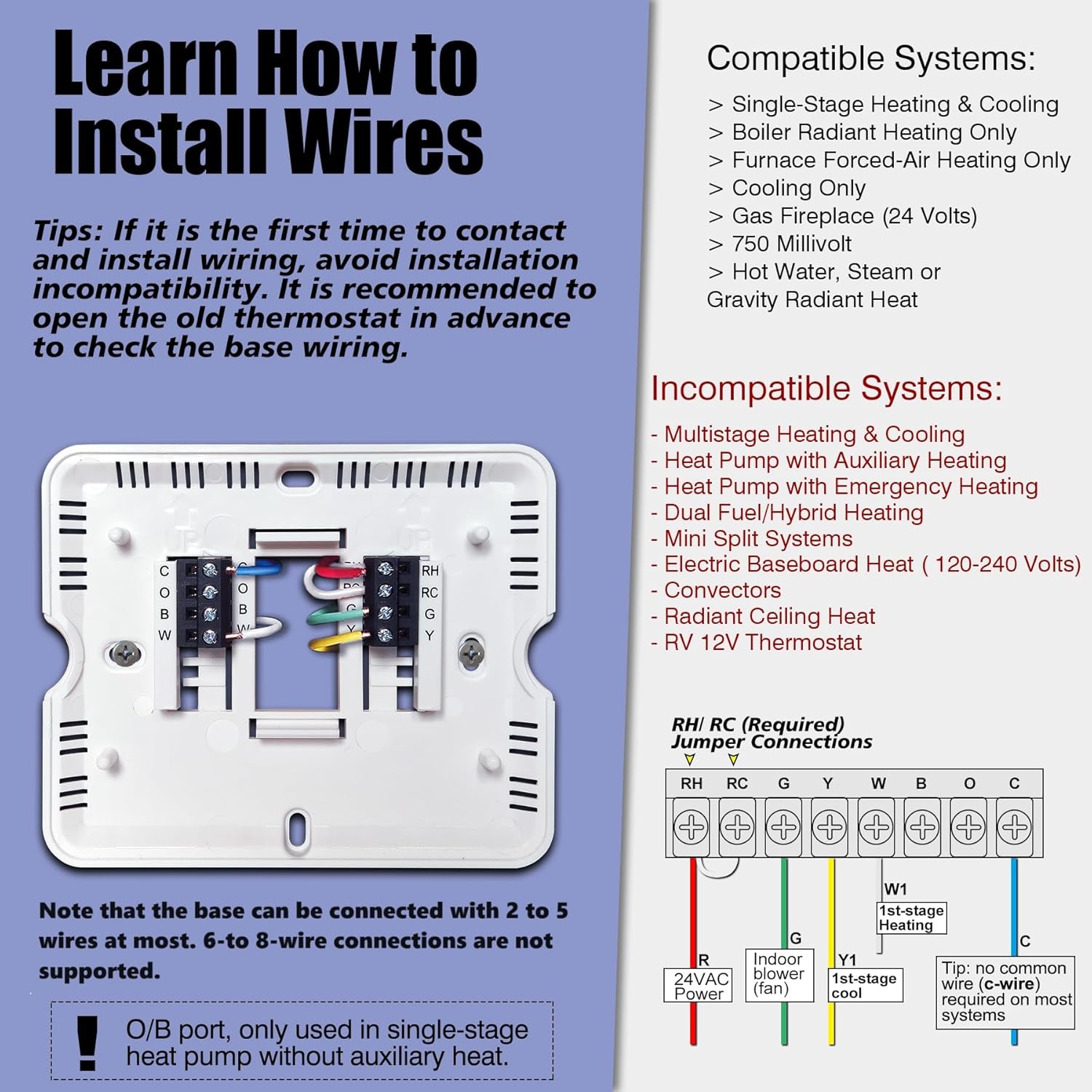Check Best Thermostat Pricing in Amazon
** As an Amazon Associate, I earn from qualifying purchases.
Have you ever glanced at your Honeywell thermostat and wondered what “Em Heat” means? You’re not alone.
This seemingly mysterious setting can be a source of confusion for many homeowners. Is it something you should be using? Is it going to save you money, or could it unexpectedly spike your energy bills? Understanding your thermostat’s settings is crucial, not just for comfort, but for efficiency and cost-effectiveness in your home.
By the end of this article, you’ll have a clear grasp of what Em Heat is, when you should use it, and how it can impact your energy consumption. Prepare to unlock the full potential of your Honeywell thermostat and take control of your home’s climate like never before. Dive in to discover the answers you’ve been seeking.
Understanding Em Heat
Understanding EM Heat in your Honeywell thermostat is crucial. It helps maintain comfort during the cold months. Many people encounter EM Heat but don’t grasp its function. Let’s dive into what EM Heat means and how it works.
What Is Em Heat?
EM Heat stands for Emergency Heat. It’s a backup heating source in your thermostat. Typically used during extreme cold or system failure. It relies on electric heat strips within the HVAC system. EM Heat provides warmth when the primary system can’t.
When Should You Use Em Heat?
EM Heat is not for regular use. It’s designed for emergencies or severe weather. Use it when your heat pump fails. It might be needed during ice storms or freezing conditions. Always consult a professional before relying on EM Heat.
How Does Em Heat Affect Energy Usage?
Using EM Heat increases energy consumption. The system uses more electricity than regular heat. It’s less efficient than your primary heating source. Expect higher energy bills if EM Heat is active for long periods. Limit usage to emergencies.
Benefits Of Understanding Em Heat
Knowing EM Heat function helps you manage your thermostat better. It ensures you use it correctly during emergencies. Understanding its impact on energy can save money. It prevents unnecessary strain on your HVAC system.

Credit: www.djpv.com.br
Purpose Of Emergency Heat
Understanding the purpose of emergency heat on your Honeywell thermostat can save you from chilly surprises. It plays a crucial role in maintaining warmth during extreme cold conditions. Let’s dive into the specifics of why this feature exists and how it can serve your heating needs.
What Is Emergency Heat?
Emergency heat is a backup heating system. It activates when your primary heat pump fails. This system ensures your home stays warm. It uses electric heat strips or gas burners. These provide immediate warmth when needed.
Why Use Emergency Heat?
Emergency heat kicks in during freezing temperatures. It ensures consistent heating when your heat pump struggles. This feature is vital for homes in colder regions. It prevents discomfort by quickly warming your home.
When To Activate Emergency Heat?
Activate emergency heat during severe cold spells. Use it when the heat pump cannot keep up. It’s also useful when the heat pump is under repair. This ensures uninterrupted warmth in your home.
Benefits Of Emergency Heat
Emergency heat offers peace of mind. It provides a reliable backup in extreme conditions. You can maintain comfort without worrying about system failures. This feature is a safety net for homeowners.
How Em Heat Functions
Em Heat on a Honeywell thermostat stands for Emergency Heat. It activates when the primary heating system fails. This setting uses the backup heat source to keep your home warm during cold weather.
Understanding how Emergency Heat (EM Heat) functions on your Honeywell thermostat can be the key to keeping your home comfortable during harsh winter months. EM Heat is a backup heating source used when your heat pump can’t efficiently warm your home. This feature ensures that you never have to experience the chill of a malfunctioning primary system. Whether you’re facing a sudden cold snap or your heat pump needs a break, EM Heat is your reliable ally.System Activation
Activating EM Heat is straightforward. It’s designed to kick in automatically when your thermostat senses that your heat pump is struggling. This can happen during extremely cold weather when the heat pump can’t extract enough heat from the outside air. You might notice your thermostat display indicating EM Heat. This is your signal that the system has shifted gears to keep you warm. Ever wondered what triggers this switch? It’s not magic; it’s smart technology. The thermostat monitors the indoor temperature and if it drops below the set point, EM Heat activates. You can also manually turn it on through your thermostat settings. This feature is particularly useful if your primary heating system fails.Temperature Regulation
With EM Heat, maintaining a stable indoor temperature is a breeze. It uses electric resistance heating, which is more reliable in severe cold. This means your home stays cozy even when the heat pump struggles. Temperature regulation is crucial. If you’ve ever woken up to a freezing house, you know the importance of consistent heat. EM Heat works by ensuring that your home remains at the desired temperature, no matter how cold it gets outside. This peace of mind is invaluable during winter storms. Have you ever considered the efficiency of your heating system? While EM Heat is effective, it can be more expensive. Think of it as a safety net rather than a first choice. Using it wisely can save you money while keeping your home comfortable. In a world where reliability is key, how does EM Heat measure up for you?When To Use Em Heat
EM heat on a Honeywell thermostat is for emergencies. Use it when your heat pump fails or during extremely cold weather. This setting activates electric heat strips for immediate warmth.
Understanding when to use EM Heat on your Honeywell thermostat can be crucial for maintaining comfort in your home. EM Heat, or Emergency Heat, is a backup heating system. It’s typically used when your primary heating method—the heat pump—fails or can’t keep up with extreme cold. But when is the right time to switch to EM Heat?Cold Weather Conditions
During severe cold snaps, your heat pump might struggle to warm your home adequately. Heat pumps are efficient but can lose effectiveness as temperatures drop. If you notice your home isn’t reaching the desired temperature, it might be time to consider EM Heat. Switching to EM Heat can provide the extra warmth you need during those freezing days. Have you ever experienced a sudden drop in temperature, and your home just couldn’t keep up? That’s when EM Heat can be your best friend. Using EM Heat ensures you stay cozy even when the weather outside is anything but.Heat Pump Malfunctions
Sometimes, heat pumps can malfunction. It could be due to mechanical failures or other unforeseen issues. When this happens, EM Heat serves as a reliable backup. Imagine waking up to a chilly home because your heat pump decided to take a break. By switching to EM Heat, you ensure that your home remains warm and comfortable. It’s like having a spare tire when you get a flat; you may not use it often, but it’s crucial when needed. Before you automatically switch on EM Heat, consider if your heat pump issue might be a simple fix. Is it something you can troubleshoot? Or is it time to call in a professional? Knowing when to use EM Heat can save you both discomfort and unnecessary repair costs.Switching To Em Heat
Understanding the EM Heat setting on your Honeywell thermostat can be vital. Especially during cold months, knowing when to switch to EM Heat can save energy. It ensures your home stays warm efficiently. This setting is an essential feature for heat pumps. It serves as a backup heating source when temperatures drop significantly.
Manual Settings
Switching to EM Heat manually is straightforward. Locate the thermostat’s mode switch. Set it to EM Heat. This activates the auxiliary heating system. Manual switching is useful during extreme cold. It ensures consistent warmth. Always check the settings after switching.
Automatic Triggers
Automatic triggers for EM Heat engage when needed. The thermostat senses temperature changes. It switches to EM Heat automatically. This happens when the heat pump can’t maintain the set temperature. This feature prevents energy waste. It ensures your home remains cozy.
Check Best Thermostat Pricing in Amazon
** As an Amazon Associate, I earn from qualifying purchases.

Credit: www.tncim.com
Energy Efficiency Considerations
The “Em Heat” setting on a Honeywell thermostat stands for emergency heat. It activates when the main heat pump fails. This setting uses electric resistance heating, which can increase energy consumption. Understanding its use helps manage energy efficiency at home.
When it comes to understanding your Honeywell thermostat, energy efficiency is a critical aspect to consider. Using emergency heat, or “Em Heat,” can impact how effectively your home consumes energy. This section explores the cost implications and energy consumption related to Em Heat. By understanding these factors, you can make informed decisions that help maintain comfort while reducing energy bills.Cost Implications
Activating Em Heat can lead to a noticeable increase in your heating expenses. It’s designed as a backup system, often using less efficient heat sources. Imagine relying on an expensive backup generator instead of the main power supply—costs can skyrocket quickly. Consider whether the additional expense of Em Heat is justified for your situation. Are you facing extreme weather conditions? If not, it might be more cost-effective to stick to regular heat settings. It’s worth checking with your utility provider for detailed cost breakdowns.Energy Consumption
Em Heat tends to consume more energy compared to regular heating modes. This is because it often uses electricity to generate heat, which can be less efficient than other systems. Picture driving a car in low gear—it requires more fuel for less output. Evaluate your thermostat settings and usage habits. Are you using Em Heat frequently or only during emergencies? Adjusting your settings or enhancing insulation can make a difference. Consider how often your heating system runs, and whether it’s consuming more energy than necessary. Could your home benefit from additional insulation or weatherproofing? Taking the time to review these aspects can help you make smarter choices. Are you willing to embrace small changes for big savings? Energy efficiency isn’t just about cutting costs—it’s about optimizing comfort in your home.Common Misconceptions
Understanding what “Em Heat” means on a Honeywell thermostat can be confusing. Many homeowners often misunderstand its purpose and function. This misunderstanding can lead to inefficiency and increased energy costs. Let’s delve into some common misconceptions about Em Heat.
Misuse Scenarios
Some people think Em Heat is for everyday heating. This is a common mistake. Em Heat is for emergencies, not regular use. It uses backup heat strips which consume more energy. Using it daily can cause high electric bills.
Others believe Em Heat warms the home faster. This is not true. Em Heat does not speed up heating. It simply uses a different method. Regular heat pumps should be used for normal heating needs.
Correct Usage Tips
Use Em Heat only during heat pump failures. It serves as a backup option. This ensures your home stays warm when the main system fails.
Switch it on during extreme cold. It helps when the heat pump struggles. This prevents the home from getting too cold.
Consult your manual for instructions. Proper guidance ensures correct use. This helps avoid unnecessary energy costs.
Know when to switch it off. Turn it off when the main system is fixed. This returns your thermostat to normal function.

Credit: appliance-dr.com
Troubleshooting Em Heat Issues
Understanding EM Heat on a Honeywell thermostat helps fix heating problems. EM Heat stands for Emergency Heat, used when primary heating fails. Typically activated manually, it relies on backup systems to provide warmth during malfunction.
Troubleshooting EM Heat Issues can feel like a daunting task, especially when you rely on your Honeywell thermostat to keep your home cozy during cold months. When the EM Heat setting isn’t working as expected, it might leave you wondering where to start fixing the problem. With some straightforward steps, you can identify and solve these issues without needing to call in a professional.Identifying Problems
First, check if the EM Heat mode is activated. Sometimes, the switch can be accidentally flipped, causing confusion. Next, listen for unusual noises from your heating system. Buzzing or clicking sounds could indicate mechanical issues. Look for inconsistent heating. If your home feels colder in certain areas, it might be a sign of a malfunctioning heat pump.Solutions And Fixes
Start by resetting your thermostat. It can resolve minor glitches and restore functionality. Inspect your air filters; dirty filters can restrict airflow and impact heating efficiency. Changing them regularly can prevent this. Consider checking your circuit breaker. A tripped breaker can cut power to your system, affecting its performance. Regular maintenance is crucial. Schedule routine checks to keep your system in top shape. Reflect on this: When was the last time you serviced your heating system? Regular upkeep can save you from unexpected breakdowns and costly repairs.Frequently Asked Questions
Should My Thermostat Be On Heat Or Em Heat?
Set your thermostat to “heat” for normal operation. Use “em heat” in emergencies when the heat pump fails.
How Long Can I Run Emergency Heat?
Run emergency heat for short durations, typically a few hours, to prevent system strain and high energy bills. Ensure your main heating source is repaired promptly to avoid prolonged reliance on emergency heat. Always check your HVAC system’s manual for specific guidelines and consult professionals when needed.
What Happens If I Accidentally Turn On Emergency Heat?
Accidentally turning on emergency heat may increase energy costs. Check your thermostat settings to switch it off. Emergency heat is for backup during heating system failures, so turning it on unnecessarily can lead to higher bills. Ensure regular maintenance to avoid accidental usage.
How To Get Thermostat Off Emergency Heat?
Switch the thermostat from “Emergency Heat” to “Heat” mode. Ensure the system is set to “Auto” or “On. ” Check the thermostat settings and replace batteries if needed. If problems persist, consult your HVAC manual or contact a professional technician for assistance.
Conclusion
Understanding “Em Heat” on your Honeywell thermostat can save you money. It offers backup heating during cold weather. This setting ensures your home stays warm. Use it wisely to conserve energy. Always monitor the setting for efficiency. Regular checks on your thermostat help maintain comfort.
Knowing how it works benefits your heating system. Stay informed and keep your house cozy. Consider professional advice if unsure. The right settings make a big difference. Adjusting correctly ensures warmth and cost-effectiveness. Em Heat is a valuable feature. Use it smartly for better energy management.
Check Best Thermostat Pricing in Amazon
** As an Amazon Associate, I earn from qualifying purchases.


